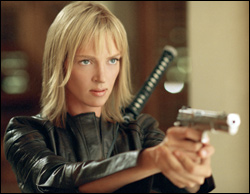What a difference five months doesn’t make. Cineastes were all waiting to see what would become of the Gordian gamble Miramax took by splitting Quentin Tarantino’s chopsocky epic into two parts. Sure, the first was a self-indulgent film-geek letdown, but the second, we were led to believe, would provide the payoff. Chat-room buzz had it that the final showdown between Uma Thurman and David Carradine would take place on this side of the ocean, a little closer to QT’s Pulp Fiction vernacular, a lot farther from subtitled samurai screams. Vol. 2 was supposed to be less foreign, less coded to the director’s pot-hazed, screening-room Proustian riffing, less driven by action, and more sustained by dialogue.
Well, now we can call Harvey Weinstein’s bluff (and understand why he was bluffing and stalling). There is no payoff to Kill Bill Vol. 2 (which opens Friday, April 16, at the Neptune and other theaters). It’s more of the same, only more so: Tarantino the pedant drones on, drowning out Tarantino the writer of ace dialogue. The entire movie seems composed from a blackboard—like Jack Black’s manic music-history lesson in School of Rock. Given carte blanche by studio, stars, and his adoring public, the reclusive writer-director has pulled a Wachowski on us and, after a somewhat audacious start in Vol. 1, has proceeded directly to the familiar “What was that all about?” sensation of The Matrix Revolutions. Where’s the Architect when you need him?
Vol. 2 begins with a funny B-movie prelude in which Thurman—still known as the Bride, though her true name is later revealed— reiterates her vow of revenge. Like we’d forgotten. (If you have: She’s pledged to exact a mortal penalty from her former boyfriend, who shot her in the head, sending her into a four-year coma.) It’s cheesy in a way that’s outside the usual Tarantino pantheon of cheese. With cheapo black-and-white rear-screen projection, Thurman is like some Lana Turner figure in a Charles Busch send-up. (There’s always been something rangy and mannish about Thurman, but that’s a different subject.) Then the movie begins properly, in color, as marked-for-death brothers Budd (Michael Madson) and Bill (Carradine) commiserate in Barstow, Calif., where Budd makes like a trailer-park Camus: “I don’t dodge guilt, and I don’t Jew out of paying my comeuppance. We deserve to die.”
From there, Vol. 2 offers no drama, just execution. And references—more film and TV entries from the Tarantino Britannica. With Carradine, you’ve got Kung Fu (complete with flute, God help us). With eyepatched-assassin Daryl Hannah, you’ve got They Call Her One Eye. With the final showdown down Mexico way, you’ve got late-career Peckinpah, with straight tequila, scarred whores, and sage pimps.
Vol. 2 ultimately becomes trivial by sheer weight of its trivia. Vol. 1 established that Tarantino wanted to craft a genre- hopping homage to all his childhood obsessions—on screens large and small. (I’m giving nothing away to say that the happy end here includes a kid watching TV.) On the DVD for Vol. 1 (also released this week in a synergistic frenzy of hype), Tarantino explains, “That’s what the whole movie is about—it’s fusion.” Cold fusion is more like it. Ennio Morricone and ’70s funk, yakuza and cowboys, the Shaw Brothers and Brian De Palma . . . where does this hybrid chain of references end? At a kind of chopsocky melodrama finale, with swords crossed between parents, both demanding sole custody of their child. (QT, let’s recall, was raised by his mother.) Vol. 1 established that the Bride gave birth in a coma after she was shot—four years later, there’s got to be an adorable little girl, right? Here, it’s like Tarantino has switched channels from Sonny Chiba’s Shadow Warriors to a daytime soap. And all that winking won’t get the sap out of your eye.
There is no unifying artistic vision or Pulp Fiction moral to this collage; it creates nothing more than a succession of pointillist nodes and nods. Tarantino’s like the guy who keeps you up all night playing forgotten B-sides from his endless collection of 45s. He’s a serial thinker who’s lost all sight of structure (which at least Elmore Leonard supplied for him in Jackie Brown). He can only recapitulate all his old faves and influences, with no means of tying them together other than to say, “Look what these things mean to me!” In a sweet shut-in’s way, he means to be generous with us, but the results in Vol. 2 are long-winded, lax, and tediously digressive.
Vol. 1 at least offered some stylish action and music, but Vol. 2‘s dominant impressions are of Hannah prattling on about milligrams of snake venom; Carradine opining about Superman; plus an overlong flashback to the Bride’s exhaustive training at a martial-arts temple run by a beard-stroking super-geezer with eyebrows like two albino sparrows.
As a rule, I don’t like to review the audience, but in this case it was pretty telling. At the preview I attended two weeks ago, there was full-on sweaty, smelly, fan-boy excitement before the curtain. Once the lights dimmed, however, I couldn’t believe how few laughs I heard over 135 minutes, how little oohing and aahing. Even the geeks seemed as bored as I was. If Tarantino can’t please these guys, he needs to reconsider his whole record-skipping aesthetic. Maybe he should choose just one genre to goof on (like Mel Brooks or Charles Busch), or treat all his bent homages with less respect and more irreverence (like the Zucker brothers).
The mood at the preview wasn’t, “This is great!” It was more like, “I think I understood that reference correctly.” It felt like an exam we’d all grimly passed together, the SAQT.








